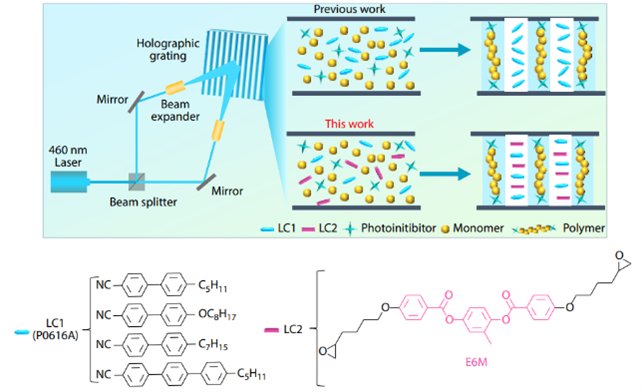
Pushing the limits of AR: high-refractive-index-modulation nanocomposites for broader realities

Schematic illustration on the construction of high-performance LC-based holographic polymer nanocomposites by doping E6M. P0616A was commercially available LC in nematic phase.
USA, September 2, 2024 /EINPresswire.com/ -- Significant progress in augmented reality (AR) technology has been made with the creation of holographic polymer nanocomposites. These materials exhibit a high refractive index modulation of 0.050 at 633 nm, coupled with a minimal haze of 5.0%. This innovation significantly advances the capabilities of AR devices by enhancing both the field of view and brightness, without adding bulk, thus facilitating more vivid and expansive user interactions within augmented environments.
Holographic optical elements (HOEs) are essential in AR displays, providing benefits like design flexibility and improved optical efficiency. However, current materials’ limited refractive index modulation hampers performance, particularly in achieving a broader field of view and increased brightness. Addressing these challenges, researchers are now focused on developing materials that can enhance refractive index modulation, which is the cornerstone of this study.
Conducted by a team from Huazhong University of Science and Technology, and published in the Chinese Journal of Polymer Science on April 10, 2024, the study (DOI: 10.1007/s10118-024-3110-z) showcases a breakthrough in holographic polymer nanocomposites by incorporating the liquid crystal E6M. This approach significantly improves refractive index modulation while reducing haze, paving the way for more efficient and compact AR devices, and marking a significant advancement in augmented reality technology.
The study's integration of E6M into polymer nanocomposites represents a major advancement. The liquid crystal enhances molecular alignment, achieving a refractive index modulation of 0.050 at 633 nm and maintaining haze at just 5.0% with a 5 wt% concentration. These enhancements lead to a high diffraction efficiency of 96.2% with a minimal thickness of 5 μm, addressing the challenge of balancing optical performance with material thinness. This makes the composites ideal for next-generation AR devices where efficiency and compactness are crucial.
Professor Hai-Yan Peng, the study’s corresponding author, highlighted the innovation's potential, “Our work demonstrates a major improvement in the optical performance of holographic polymer nanocomposites, which could transform AR device design. Achieving high diffraction efficiency with minimal thickness sets the stage for thinner, lighter, and more efficient AR displays.”
The advanced holographic polymer nanocomposites offer significant implications for the AR industry, especially in developing future display technologies. Achieving high optical performance with reduced material thickness and low haze enables the creation of more compact and efficient AR devices. This advancement could drive wider adoption of AR technology across sectors like healthcare, education, and entertainment, enhancing user experiences and spurring innovation industry-wide.
DOI
10.1007/s10118-024-3110-z
Original Source URL
https://doi.org/10.1007/s10118-024-3110-z
Funding information
This work was financially supported by the National Natural Science Foundation of China (Nos. 52122316, 52073108 and 52233005) and the Innovation and Talent Recruitment Base of New Energy Chemistry and Device (No. B21003). Analytical assistance from HUST Analytical & Testing Center, and Core Facilities of Life Sciences are also appreciated.
Lucy Wang
BioDesign Research
email us here
Distribution channels: Chemical Industry, Science
Legal Disclaimer:
EIN Presswire provides this news content "as is" without warranty of any kind. We do not accept any responsibility or liability for the accuracy, content, images, videos, licenses, completeness, legality, or reliability of the information contained in this article. If you have any complaints or copyright issues related to this article, kindly contact the author above.
Submit your press release